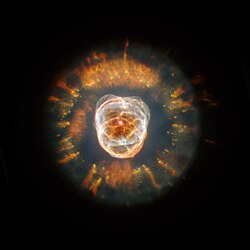NGC 2392, the Lion Nebula.
Clown-faced Nebula, Lion Nebula
The Eskimo Nebula (NGC 2392), also known as the Clown-faced Nebula, Lion Nebula,[4] or Caldwell 39, is a bipolar[5] double-shell[6] planetary nebula (PN). It was discovered by astronomer William Herschelin 1787. The formation resembles a person's head surrounded by a parka hood. It is surrounded by gas that composed the outer layers of a Sun-like star. The visible inner filaments are ejected by a strong wind of particles from the central star. The outer disk contains unusual, light-year-long filaments.
NGC 2392 lies about 6500 light-years away, and is visible with a small telescope in the constellation of Gemini.
The nebula was discovered by William Herschel on January 17, 1787, in Slough, England. He described it as "A star 9th magnitude with a pretty bright middle, nebulosity equally dispersed all around. A very remarkable phenomenon."[7] NGC 2392 WH IV-45 is included in the Astronomical League's Herschel 400 observing program.
| Observation data: J2000 epoch | |
|---|---|
| Right ascension | 07h 29m 10.7669s[1] |
| Declination | +20° 54′ 42.488″[1] |
| Distance | 6520±560[2] ly |
| Apparent magnitude (V) | 10.1[1] |
| Apparent dimensions (V) | 48″; × 48″;[3] |
| Constellation | Gemini |
| Physical characteristics | |
| Radius | ≥0.34 ly[a] ly |
| Absolute magnitude (V) | ≤0.4 [b] |
| Notable features | – |
| Designations | NGC 2392,[1] Caldwell 39, PN G197.8+17.3 Central Star: HIP 36369, HD 59088, TYC 1372-1287-1 |
https://en.wikipedia.org/wiki/Eskimo_Nebula
| Emission nebula | |
|---|---|
| Planetary nebula | |
 |

No comments:
Post a Comment